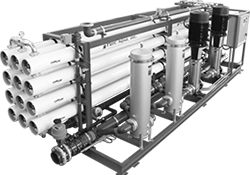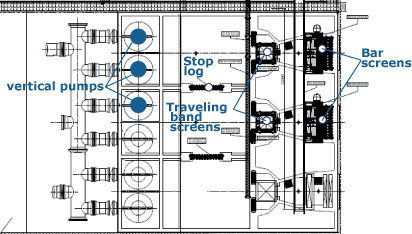 SWRO plant production capacity and operation modes are 2 inseparable halves. The clients and the designers shall be in full agreement about them as they may define "a family car" or "a racer" differing in price by more than 100%! For example, the seawater intake filtering system withstanding the jellyfish inrush lasting just several days a year is 3 times more expensive than the ordinary traveling band screen.
SWRO plant production capacity and operation modes are 2 inseparable halves. The clients and the designers shall be in full agreement about them as they may define "a family car" or "a racer" differing in price by more than 100%! For example, the seawater intake filtering system withstanding the jellyfish inrush lasting just several days a year is 3 times more expensive than the ordinary traveling band screen.
Constant feed pressure and flowrate
At this operation mode the seawater pressure before RO membranes is always constant. All pumps are kept operated at the same operation point around-the-clock. This mode advantages are as follows.
- simplicity of design and control - no variable speed drives
- simplicity of operation - the load of the plant is not controlled and follows the seawater temperatures in inverse manner
- enhanced reliability due to stable operation pressures
CPF has the following drawbacks.
- such a plant can't be operated in stand-alone mode characterized by absolute match between consumption and production
- possible degradation in the production over time due to the membrane fouling (between the membrane replacements)
- 'natural' decrease in production due to low seawater temperatures in winter time
Constant demand
Constant production mode is often specified by the client in cases when information about actual water consumption and its predicted growth is not available. The client may stay under the illusion that under the above-mentioned circumstances this mode is the simplest to implement. But the reality is quite the reverse. Not seldom the plant designers consider the constant production requirement as a constant hourly production and sometimes end up with extremely sophisticated and expensive design in terms of reliability and maintainability. To maintain the production constant at varying seawater temperatures and the RO membranes fouling 2 controllable parameters are engaged: 1. feed pressure 2. recovery.
At winter time higher pressures and lower recoveries are used. To implement such operation mode the seawater pumps shall be equipped with the variable speed drives, both being oversized by 10 - 20%. The energy-recovery devices like ERI type are susceptible to transient performance associated with the recovery control, and extra instrumentation and standby units are to be added.
Constant monthly demand
This mode defines the monthly quantities irrespective of the daily production rates. It allows the plant designers to relax the requirements for the equipment availability and maintainability and to use more flexible Preventive Maintenance Plans (PMP) as regards the pumps overhaul, CIP and the RO membrane replacement. The designer may feel at ease about jellyfish inrush or high TSS (total suspended solids) during stormy weather.
Varying demand
 It is expected that the varying demand absorb seasonal variations and the consumption growth over time. Actually most tenders treat the seasonal variations as the basis for the design, and don't consider the plant extensibility an important criterion of the overall design goodness. (The observation shows that any seawater desalination plant will be eventually refurbished and extended within the first 10 years of operation.)
It is expected that the varying demand absorb seasonal variations and the consumption growth over time. Actually most tenders treat the seasonal variations as the basis for the design, and don't consider the plant extensibility an important criterion of the overall design goodness. (The observation shows that any seawater desalination plant will be eventually refurbished and extended within the first 10 years of operation.)
As a rule the news about planned future extension unexpectedly surfaces at the end of the project when the plant common facilities are under construction (underdrain system, chemical storage, switchgears, etc.). The figure to the left shows extended intake station example taken from a real project. This design contains 3 pumps each covering 50% of demand and belonging in different compartments (!) and 2 traveling band screens each for 100% of capacity. Despite good intensions, this design is not 100% dependable and flexible (limited possibility of the standby pump swapping).
For Middle East countries the seasonal variation in water consumption is within the range of 60 - 100% (The author estimate). Such turn-down ratios pose no technical limitations on the known desalination plant layout options - pressure center design or multiple parallel stand-alone trains. To select the optimal strategy for partial load covering - unloading (for parallel trains and the pressure center) or decreasing a number of trains in operation - the impact of low loads on the RO membrane feed and product quality shall be additionally analyzed. Fortunately, low loads usually occur during winter time when membranes produce water of highest quality due to the temperature effect.
Varying daily demand
 Seawater desalination is an energy-intensive process: about 3.5 kWh is required for 1 m3 of produced water. For the plant producing 100 million m3 of water annually the absolute power consumption may reach 40MW. Unlike water consumption which is relatively uniform in many cases, power demand is undergone high-amplitude seasonal and diurnal variation with minimum load equal to 25 - 30% of summer peak, power and water demands are not necessarily synchronized. The typical ambient temperature and power load seasonal profile curves of the Middle East countries are shown in the right figure. Air conditioning load is the major contributor to the power load variation, and lower ambient temperatures coincide with decreased power demand period.
Seawater desalination is an energy-intensive process: about 3.5 kWh is required for 1 m3 of produced water. For the plant producing 100 million m3 of water annually the absolute power consumption may reach 40MW. Unlike water consumption which is relatively uniform in many cases, power demand is undergone high-amplitude seasonal and diurnal variation with minimum load equal to 25 - 30% of summer peak, power and water demands are not necessarily synchronized. The typical ambient temperature and power load seasonal profile curves of the Middle East countries are shown in the right figure. Air conditioning load is the major contributor to the power load variation, and lower ambient temperatures coincide with decreased power demand period.
The seawater desalination plant may be effectively engaged in the peak shaving - the reduction of the amount of electricity drawn from a power utility during utility designated peak time periods. In this mode of operation the plant doesn't produce water during noon peak hours when the electricity tariffs are the highest. The capacity of the desalination plant operated in such a mode has to be bigger by at least 10- 15% %, and the plant shall be designed at least for 300 startups annually. In rare cases of mechanical outages the extra capacity mentioned may be used as a standby reserve.
The peak-shaving economics of desalination plants equipped with the water storage shall be part of the plant feasility study.
